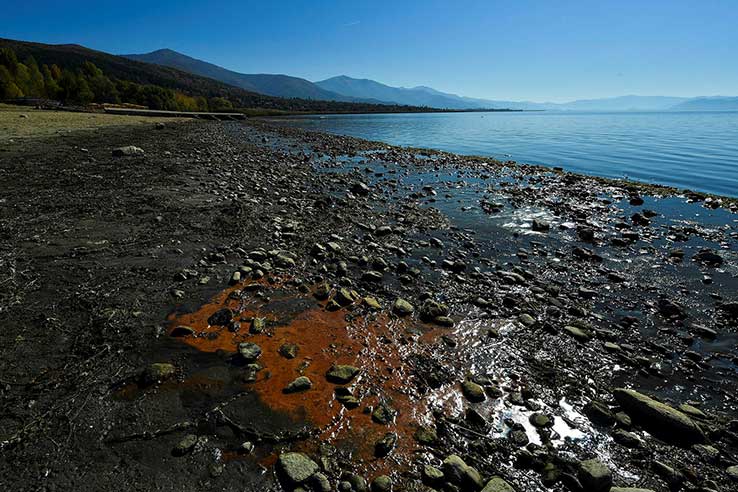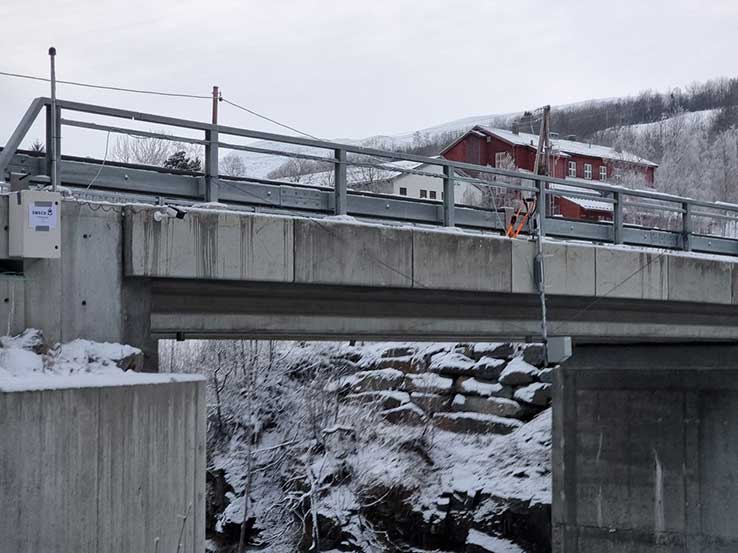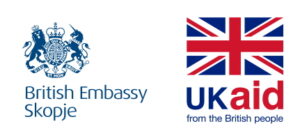Prof. Slaven Conevski, Todor Conevski, Prof. Svetislav Krstiq Ph.D.
 It is not possible to calculate exactly the proper utilization and capacities of the water resources in the country due to the lack of continuous hydrological measurements and monitoring of the water quality.
It is not possible to calculate exactly the proper utilization and capacities of the water resources in the country due to the lack of continuous hydrological measurements and monitoring of the water quality.
Only 2% of the territory of the Republic of North Macedonia is covered by water. There are more than 65 rivers, 3 large natural lakes (Ohrid, Prespa and Dojran), at least 40 smaller natural lakes and about 120 artificial lakes on the national territory. In terms of quantities, North Macedonia belongs to areas that have satisfactory water resources, but their territorial distribution is uneven. Although there is some data available, It is not possible to calculate exactly the proper utilization and capacities of the water resources in the country due to the lack of continuous hydrological measurements and monitoring of the water quality.
According to the Macedonian Hydrometeorological Service (UHMR), there are a total of 110 official hydrological stations that are used for measurement of the surface water flow, this number is 115 for groundwater. If we correlate this number with the total number of water bodies, the conclusion will be that there is less than one measuring station per water body. By comparison, the ratio of measuring stations and water bodies in Italy is about twice as high, and in Norway it is more than five times higher.
The lack of hydrological data is an obstacle for implementation of the European Water Framework Directive
The insufficient number of measurements as well as untimely processing of the data is a serious obstacle in the implementation of the EU Water Framework Directive and its accompanying and relevant directives (e.g. Directive on the protection of groundwater against pollution and deterioration of quality, Management of bathing water quality Directive, etc.) which are mainly introduced and transposed in our Law on Waters. Nevertheless, no adequate system for measurement and collection/ storage of quantitative data has been established to date, nor is there a continuous field monitoring of the quality of the water bodies.
A simple interpretation of part of the Water Framework Directive (WFD) would be: i) a territorial unit on which water resources management is planned is a river/ lake watershed, and; ii) all water bodies on the Macedonian territory should to improve their status (in a short time and in relation to the existing (bad) condition) into a higher qualitative category. For example, if the waters of Prespa Lake and all the tributaries in the lake watershed are identified as waters with poor-moderate quality, based on historic scientific and in-depth research, they should be brought up to the level of a higher category of water quality – good, using measures determined by experts. A specific problem in defining measures in the plan is the insufficient data on water flows in the tributaries, the water quality in the rivers and in the lake itself, but also the consumption and pumping of irrigation water by local agricultural and industrial users. The Prespa Lake Watershed Management Plan had its second upgrade – it is the only one in the Balkan region. So far, basic versions of river/ lake watershed management plans have been prepared, but there was no upgrade of those plans after 6 years, which is the validity period for such a plan according to the Water Framework Directive. However, the implementation of the strictly prescribed measures is not at a satisfactory level today.
 Source: sdk.mk
Source: sdk.mk
The data as an essential tool in managing water resources
The existing information (water flow, water quality, water level, groundwater level, etc.) and the current manner of their collection, storage, their format and processing - are not sufficient to enable additional detailed statistical and hydrological analyzes, especially for shorter time periods (eg. hour/ day) which, in turn, are necessary for modeling the stochastic processes, such as the climate change. If we add to this the obsolete hardware and software and/ or the need to catch up with the European and global achievements in this field, including the lack of highly profiled experts (there are very few and insufficient in the UHMR and at universities, especially at UKIM university), the need for sounding the alarm in this field/ activity is evident.
It peculiar that there are many studies and reports showing the need for proper water management and planning, where many measures are listed, but there is no detailed analysis of their implementation. In many cases the situation is complex and the proposed measures cannot be practically implemented. For example, the restoration of a riverbed requires hydrological data from several locations in the catchment area, as well as water flow measurements after each important tributary. Additional data on vegetation, fauna, and the entire ecological system are also required. If there is a need for information on the sediment and erosion in the watershed, the complexity becomes huge, especially given the frustratingly difficult way of measuring the sediment in the rivers or the erosion in the watershed. The volume of such data is huge and shall take at least 50 years in order to come up with satisfactory analysis and proper design of the system. There is probably no river in North Macedonia for which all this necessary information is available. In other words, the challenges and problems of improving the quality management and the use of water in our country, unfortunately, are only superficially analyzed and many of the solutions are based on assumptions or inappropriate empiricism (eg. laboratory-derived formulas).
The uneven distribution of water resources, as well as the uncontrolled consumption exercise additional pressure on the environmental systems, which further complicates the management and planning. This also includes the issue of waste water where the bad monitoring network prevents proper management. For example, only 5% of the wastewater in North Macedonia is properly treated before being discharged into rivers or lakes. This percentage is not only devastating, but it is probably even lower because its accuracy has not been fully analyzed and is not publicly available. By comparison, the EU Wastewater Directive requires primary and secondary wastewater treatment for areas with more than 2,000 inhabitant equivalents.
The ascertainment that the wastewater is minimally treated is clearly reflected in the reports of the scientific and expert teams (UHMR, Water Quality in the zones of Rashche, Nerezi-Lepenec and Skopsko Pole, 2009-2010; AS, 2014-2015; Partners, 2016), but not in the official, even the most recent, annual reports of UHMR. The many measuring points that have been analyzed in the frames of these projects indicate the fact that the region is dominated by the fourth and fifth categories of water quality in the studied river ecosystems, while other categories that would be indicative of cleaner waters are quite rare. This ascertained situation indicates the existence of continuous pressure on the river ecosystems originating from poorly or untreated municipal and industrial wastewater.
The situation of the three natural lakes and most of the water reservoirs in the country is also alarming. There are many publications and projects that indicate that parts, entire regions or the total area of Lake Prespa, as well as parts of Lake Ohrid are under intense pressure from eutrophication originating from the catchment area and/ or agricultural areas (Geotechnical Engineering, Upgrading the Lake Prespa Watershed Management Plan, 2016; Geotechnical Engineering, Lake Prespa Watershed Management Plan, 2011). The worst is the ecological situation with Dojran Lake (REC, 2015, 2016; Milleukontakt, 2019; CEPF 2020-2021) for which a high rate of eutrophication is continuously ascertained determined with increased occurrence of the harmful "water flower" that consists of blue-green algae, which have been also confirmed to be toxic. There is absolutely no government monitoring of the natural lakes and water reservoirs based on RDV, such monitoring is taking place chaotically, ad hoc, without adherence (or contrary) to the proposed methodologies and control of the result within the national laws and RDV.
 Source: The authors
Source: The authors
The need for continuous monitoring
It is obvious that every activity aimed at watershed management is essentially based on relevant, accurate and verified data obtained with the use of various monitoring systems foreseen in the European directive and the national legislation. To date, no adequate monitoring system of surface and groundwater bodies has been established in North Macedonia. This is because of many problems, but mainly due to insufficient staffing, lack of financial support, lack of interest from the government, as well as a properly built monitoring system in which there is involvement of the practitioners (UHMR) and the academic community as controllers of the method, application and the results obtained from the monitoring, using the existing scientific knowledge.
The lack of detailed evaluation (eg. due to lack of data) of the available water quantities, the degree of their utilization and their quality reduces the possibility for preparation and implementation of detailed plans and strategies for better management of water resources. At the same time, this is often an obstacle for preparation of detailed project applications for calls sponsored by international foundations, most often by the EU or the World Bank, although the leading role here is played by the Government of the Swiss Confederation through its State Secretariat for Economic Affairs (SECO) and the Swiss Agency for Development and Cooperation (SDC). Similar ascertainments were also included in the recent press conference of UHMR where they emphasized the need for funds and human resources (currently there are only eight people working on this and the budget is only 8,000 euros per year), as well as for general improvement of the entire monitoring network in Macedonia.
The most recent European Conference on waters organized in 2018 presented the most important points of EVD, as well as the progress of the European Union in terms of implementation of the measures and objectives of the Directive. The conference points out that there is a delay in the implementation of the objectives set out in the past period (their implementation in 2025). It also points out that climate change, as well as the non-holistic approach to water resources management are the main reasons for this stagnation at European level. The so-called holistic approach means "source control" (eg. locating the source of pollution or the draining of the water and finding a preventive solution) and not an "end of pipe" approach in solving problems (for example, the problem of water shortage or water pollution is resolved by artificial inflow or on-site water treatment). This requires detailed monitoring network and creation of multidisciplinary methodology (involvement of all stakeholders) in resolving the issue of water resources.
Good practices from European countries for monitoring water resources and solving climate problems when doing hydrological analyses
The first step is planning and implementation of a new monitoring network for continuous measurement of all the necessary hydrological and qualitative data, as well as preparation of a database that will be available for the private and public sector in the Republic of North Macedonia. For example, an application has been developed in Norway (NVE atlas) which enables visualization of all measuring stations and of the data available for each river and catchment area. Apart from historical data, it is also possible to monitor the current situation at some of the stations (Xgeo). In general, the monitoring system of the water resources in Norway is more and more relevant and significant funds are allocated for financing of the monitoring network, although it is considered a country with more than a satisfactory quantity of water. At the same time, the private users are legally required to make measurements and enter the data in the database. In Italy, there is also a portal for downloading hydrological data -Portal dei dati idrologici, however, is not fully available and is not as detailed as in the Scandinavian countries. Similar portals are being developed in all European countries as one of the most important steps in dealing with water scarcity in the future.
Climate change is included in all detailed plans in Italy (for example, regulation of Lake Como and of all watersheds in Lombardy, North Italy), where state-of-the-art approaches are used to optimize water use. For example, the regulation of the water levels of Lake Como is based on a number of scenarios involving climate change over the next 100 years. In Norway, on the other hand, there is a regulation which says that climate change must be taken into account in any study or project. For simpler analyzes and studies, a percentage increase in water flows is proposed, depending on the size and location of the watershed in Norway.
In terms of climate change, the situation in North Macedonia is much more alarming. Climate change is not included at all as a necessary element in water resources management (eg. percentage correction of the water flow for river watershed planning). The "End of pipe" approach is still the most present method, as evidenced by a series of events from the recent past, such as the situation with Lake Prespa. The portal for public monitoring of water resources was promoted only a few months ago (in 2021) which does not allow for downloading of detailed data.
The above examples show that the issue of water resources management as a mean of mitigation of the climate change impact, must become a priority for the Government of the Republic of North Macedonia as soon as possible. Improving the nationwide monitoring network is the first step in identifying and locating problems. Increasing the volume of data and measurements will contribute to more effective development of management plans and strategies, but also to fast, efficient and permanent solution for water resources problems.
This insight into public policies was prepared by the Institute for European Policy (EPI) within the campaign "Clear it all” which is implemented by the Institute for Communication Studies and is funded by the British Embassy in Skopje.
Please refer to the Terms before commenting and republishing the content.
Note: The views and opinions expressed in this article are those of the author and do not necessarily reflect the views of the Institute of Communication Studies or the donor.


